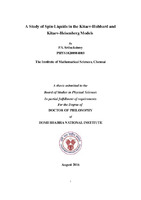- DSpace Home
- →
- IMSc Theses/ Dissertations
- →
- IMSc Theses/ Dissertations
- →
- View Item
JavaScript is disabled for your browser. Some features of this site may not work without it.
| dc.contributor.author | Sriluckshmy, P.V. | |
| dc.date.accessioned | 2016-08-19T05:41:39Z | |
| dc.date.available | 2016-08-19T05:41:39Z | |
| dc.date.issued | 2016 | |
| dc.date.submitted | 2016 | |
| dc.identifier.uri | https://dspace.imsc.res.in/xmlui/handle/123456789/382 | |
| dc.description.abstract | The study of spin liquids, an exotic phase of matter, is a rapidly growing field. Spin Liquids are, by definition, pure Mott insulators which, due to quantum fluctuations and frustration, lack magnetic order even at the lowest of temperatures. This exotic behaviour has been observed in a number of materials which include both organic and inorganic salts. It has been possible to classify, using theoretical methods, a total of 180 distinct types of spin liquids. The ground state of one of these, a Z2 type, can be solved exactly. Named the Kitaev spin liquid, this has attracted a lot of attention lately. One of its drawbacks is the sensitivity of the Kitaev model to perturbations that destabilizes the spin liquid phase, letting long-range order set in. This issue, and methods of tackling it, form the backbone of my dissertation. Among the many realisations of the Kitaev spin liquid model, I have chosen to focus on optical lattices and materials. In optical lattice systems, the Kitaev-Hubbard model is defined as a Hubbard model with spin-dependent hopping on a honeycomb lattice. When onsite interactions are large and spin-dependent hopping is strong, The Kitaev-Hubbard model has been shown to host a Kitaev spin liquid model. We have mapped out its phase diagram using numerical techniques such as the Cluster Perturbation Theory (CPT) and the Variational Cluster Approximation (VCA) method. We have detected a new phase where magnetic order is absent but the charge gap is non-zero. We show, using perturbation theory, that spin-spin correlations in this phase decay as a power law. We also show, for the first time ever, that time-reversal symmetry stabilises this new Algebraic Spin Liquid phase. Sodium Iridates $Na_2IrO_3$ and $Na_4Ir_3O_8$, were proposed to be avenues where Kitaev-like interactions might be realized because of the strong spin-orbit coupling in these 5d-materials. No smoking gun experiment has been found as yet for the detection of spin liquids or of the Kitaev model. Since iridates have recently been shown to possess Kitaev-like correlations, using Raman response as an experimental probe, we analyze Kitaev-Heisenberg model and study Raman responses in depth. Using Majorana mean field decoupling, we show that a broad Raman band at high wavenumbers with weak polarization dependence is a signature for the spin liquid in these compounds. | en_US |
| dc.publisher.publisher | The Institute of Mathematical Sciences | |
| dc.subject | Spin-Liquids | en_US |
| dc.subject | Kitaev Model | en_US |
| dc.subject | HBNI Th95 | en_US |
| dc.title | A study of spin-liquids in the Kitaev-Hubbard and Kitaev-Heisenberg Models[HBNI Th95] | en_US |
| dc.type.degree | Ph.D | en_US |
| dc.type.institution | HBNI | en_US |
| dc.description.advisor | Syed R. Hassan | |
| dc.description.pages | 205p. | en_US |
| dc.type.mainsub | Physics | en_US |
| dc.type.hbnibos | Physical Sciences |
Files in this item
This item appears in the following Collection(s)
-
IMSc Theses/ Dissertations
IMSc Theses/ Dissertations
